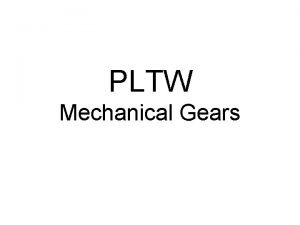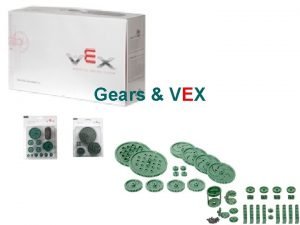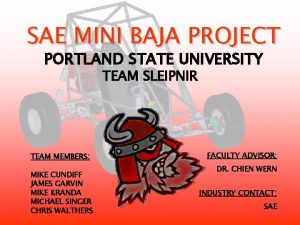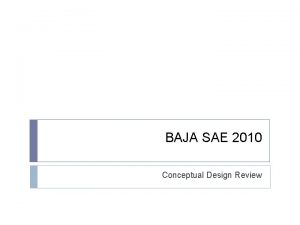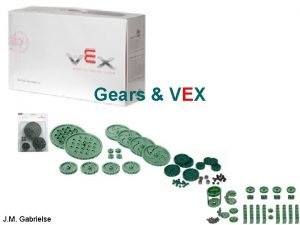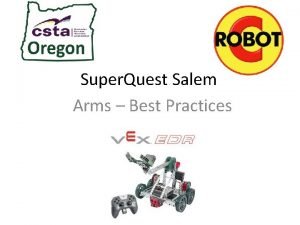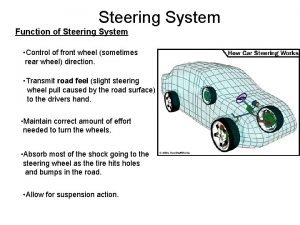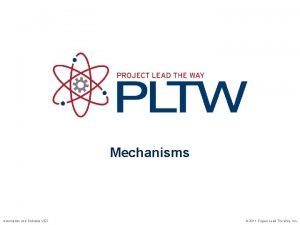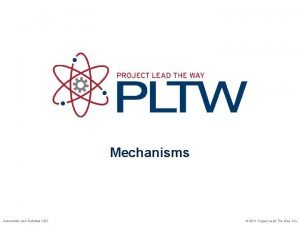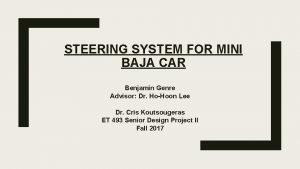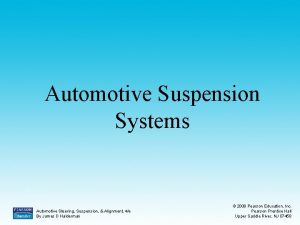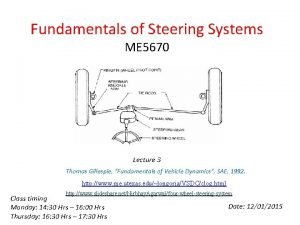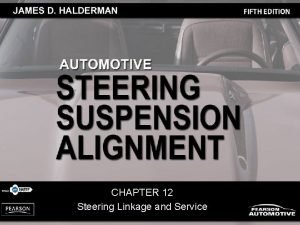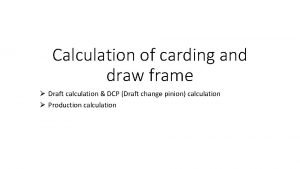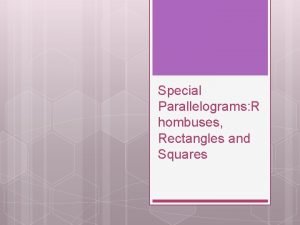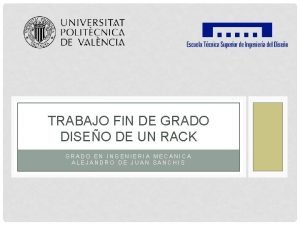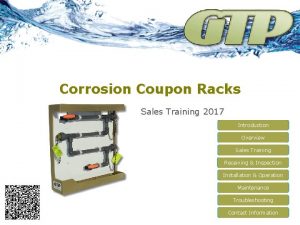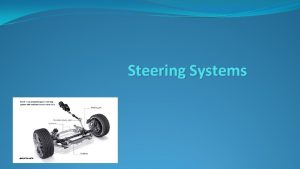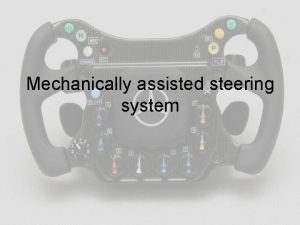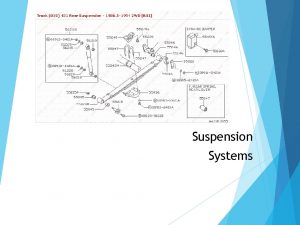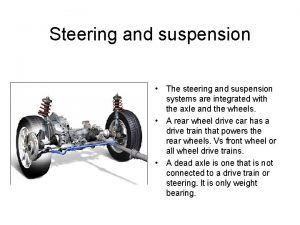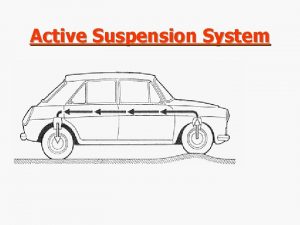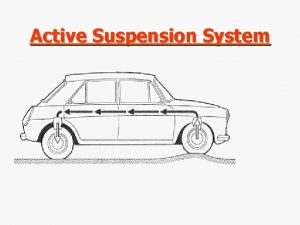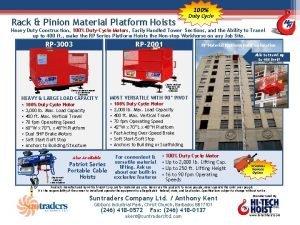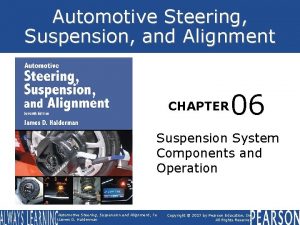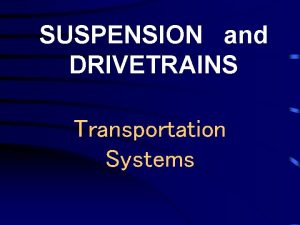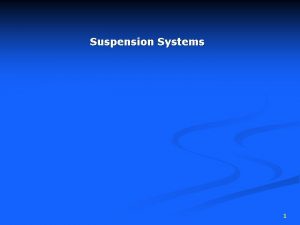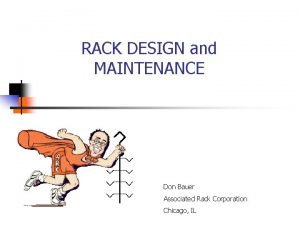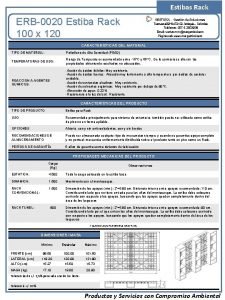Steering Suspension Systems Rack Pinion Parallelogram Parallelogram steering
























- Slides: 24

Steering / Suspension Systems


Rack & Pinion Parallelogram

Parallelogram steering �Used on older cars �Mostly used on trucks and SUV’s today �Parts of a typical system �Steering column �Gearbox �Pitman arm �Center link �Idler arm �Inner and outer tie rod ends �Steering knuckles Center Link





Rack and Pinion Steering • Used on most newer cars • Parts of a typical system • Steering column • Rack and pinion assembly • Tie rods • Steering knuckles



Power Steering • Uses hydraulic pressures to make steering easier • Parts of system • Belt • Pump • Hoses • Piston • Control valves • Power steering pump • Some are electric

Suspension Systems • Independent system • Wheels move independent of each other • Non-independent system • Movement of one wheel moves the other Solid axle

Suspension Components • Frame or unibody • Shocks • Springs Torsion bar • Leaf • Struts Air bag Chapter 14 © 2007 Rolling Hills Publishing www. Auto. Upkeep. com 14

TYPES

COIL SPRINGS Coil springs are made of special round spring steel wrapped in a helix shape. Characteristics of a coil spring (strength, etc. ) depend on: 1. 2. 3. 4. Coil diameter Number of coils Height of spring Diameter of the steel coil that forms the spring Continued






HOOKE’S LAW All suspensions use springs with a common characteristic described Robert Hooke (1635– 1703). An English physicist, he discovered force the characteristics of springs Hooke’s Law Deflection (movement or deformation) of a spring is directly proportional to the applied force. Figure 85– 8 This spring was depressed 4 inches due to a weight of 2, 000 Ib. This means that this spring has a spring rate (K) of 500 Ib per inch (2000 4 in. 500 Ib. /in. )

LEAF SPRINGS Leaf springs are constructed of one or more strips of long, narrow spring steel. These metal strips, called leaves, are assembled with plastic or synthetic rubber insulators between the leaves, allowing for freedom of movement during spring operation. Figure 85– 18 A typical leaf spring used on the rear of a pickup truck showing the plastic insulator between the leaves, which allows the spring to move without creating wear or noise. Continued

Shackles allow for rearward movement as the spring hits a bump. Figure 85– 22 Typical rear leaf-spring suspension of a rear-wheel-drive vehicle. Continued
 Pltw simple gear train
Pltw simple gear train Rack and pinion vex
Rack and pinion vex Sae baja rack and pinon
Sae baja rack and pinon Rack and pinion gear sae baja cockpit
Rack and pinion gear sae baja cockpit Rack and pinion vex
Rack and pinion vex Rack and pinion vex
Rack and pinion vex Purpose of steering system
Purpose of steering system Worm and wheel vex
Worm and wheel vex Rack and pinion vex
Rack and pinion vex Steering rack mini baja
Steering rack mini baja 4e alignment
4e alignment Dynamics
Dynamics How to perform a dry park test
How to perform a dry park test The length of rope used for suspension exercise is?
The length of rope used for suspension exercise is? What does ebon pinion mean
What does ebon pinion mean Carding machine production calculation
Carding machine production calculation Sinter gear factory
Sinter gear factory True about special parallelogram
True about special parallelogram Information systems steering committee
Information systems steering committee Partes de un rack
Partes de un rack Total rack
Total rack What is a test tube holder used for in chemistry
What is a test tube holder used for in chemistry Corrosion coupon rack installation
Corrosion coupon rack installation Organisation chart of front office
Organisation chart of front office Server rack modem
Server rack modem
